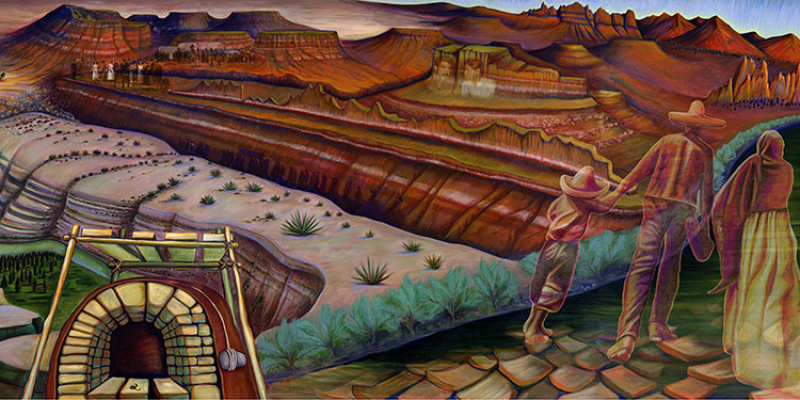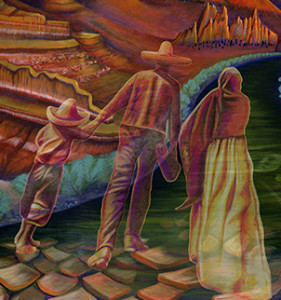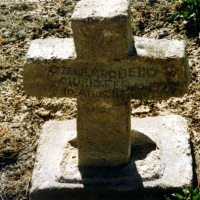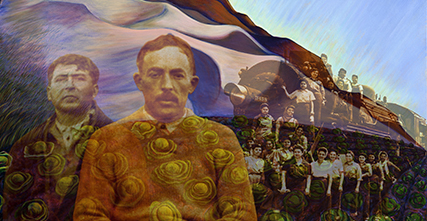In 1998, while in residency at Harvard University, SPARC’s Artistic Director, Judith F. Baca, along with her graduate students began the production of La Memoria de Nuestra Tierra for the Denver International Airport. The 10 foot by 50 foot mural tells the Hispano-Mexicano history of the Southwest with specific emphasis on the Colorado four-corners area of the United States and Northern Mexico. In particular the mural shows the migration of Mexicans through the Juarez-El Paso border region towards the north, a migration taken by Baca’s grandparents who settled in La Junta, Colorado. A landmark work in the history of Digital Murals, La Memoria de Nuestra Tierra combines a beautifully hand painted landscape with historic photographs in a seamless blend imprinted upon the holographic-like surface of a metallic coated substrate. The mural was completed in the UCLA-SPARC Digital/Mural Lab in 2000 and is currently on permanent display at the Denver International Airport.


“My mural for the Denver International Airport, entitled La Memoria de Nuestra Tierra, is of a personal nature. My grandparents came from Mexico to La Junta, Colorado during the Mexican Revolution. They followed the course traveled by thousands of other Mexican families, from Chihuahua to the United States through the historic northern territories of Mexico (Texas, New Mexico, Colorado) via the “Ellis Island” of the southwest, El Paso. It is a story that has been little chronicled and one for which I am anxious to create a visual record.
My mother was born in La Junta, educated in Colorado’s segregated school system, and raised in its’ segregated housing in the ‘1920’s and 30’s. Recently, she was successful in petitioning the governor of Colorado to intervene in the segregated graveyard of her hometown that maintained only Anglo graves. Due to my mother’s insistence, the Governor mandated preservation and maintenance for my grandfather’s grave and those of the other Mexicans who were buried in the Mexican section of the La Junta cemetery.
The simple fact that, even in death the bodies of racially different people were required to remain separate, was what moved me to create an artwork that would give dignity to the Mestizo’s story and the stories of countless others who toiled in the mines, fields, and railroads of Colorado. Not only to tell the forgotten stories of people who, like birds or water, traveled back and forth across the land freely, before there was a line that distinguished which side you were from, but to speak to our shared human condition as temporary residents of the earth.
Click thumbnail below for more images

My great-grandfather, as family mythology recites, had water rights and with a wagon delivered water to residents of the area. His bright Spanish green eyes and red hair were his distinction as were his great large horses. He is also buried there. Perhaps it was the fact that my ancestors are planted in Colorado’s soil that caused me to wonder what was recorded there in the granules of dirt, where I believe the memory of the land might reside.
In a sense this is an excavation of the Chicano/Chicana’s complexity as indigenous people, and of their multiple identities as mixed Spaniards, Africans, and Asians, living among newly immigrated Irish, Greek and Italian people. This is an excavation and a remembering of their histories. By revealing what is hidden, through pictorial iconography in the land, this mural is a kind of Mayan map not really intended to guide your path, but instead to tell you about the road.
My research located, in the La Junta Museum, photographs of railroad workers of the region, and it is there that we found the photographs of my grandfather that will be important to the narrative aspect of the work. I conducted interviews with many people of the region and a workshop with University of Southern Colorado students on the history of the region. Students brought photos and personal narratives on their family history in Colorado to the workshop, which provided me with valuable insight for this work. I visited seven local high schools and spoke with the young people, and met with scholars and archivists.

I also learned of the Luis Maria Baca Land Grant, which of course fascinated me and has encouraged research beyond the mural to know about this particular segment of land, which is the origin of so many creeks and streams. Could this be where Seferino Baca’s water rights originated?
With the use of computer technology I have incorporated these images and documents into the mural. The landscape imagery was hand-painted at a small scale and then scanned into the computer at a very high resolution for inclusion into the mural. The final work will be a printed digital aluminum tile mural fifty feet by ten feet in length, installed in the central terminal of the Denver International Airport.
It is in the making of this artwork that my family mythology and that of so many others is finding substance in place.”
-Judy Baca
[template id=”8100″]